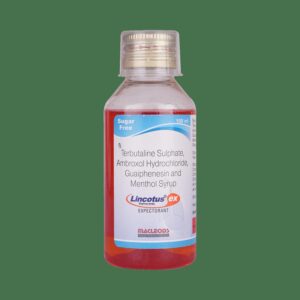TERBUTALINE + BROMHEXIHE + GUAIPHENSIN
Terbutaline: Terbutaline is a medication primarily used to treat breathing difficulties caused by bronchospasm in conditions such as asthma, chronic obstructive pulmonary disease (COPD), and bronchitis. It belongs to a class of drugs known as beta-2 adrenergic agonists.
The mechanism of action of terbutaline involves stimulating the beta-2 adrenergic receptors in the smooth muscles of the airways. By activating these receptors, terbutaline relaxes the muscles, leading to bronchodilation and improved airflow to the lungs.
Terbutaline is available in multiple forms, including oral tablets, inhalers, and injections. The recommended dose may vary depending on the severity of the condition, age, and individual response. Typically, for oral tablets, the usual starting dose is 2.5 mg taken orally every six hours, with a maximum of 30 mg in 24 hours. Inhalation doses from the aerosol inhaler range from 0.25 to 0.5 mg every four to six hours.
While terbutaline provides relief for respiratory conditions, it is important to note that it does not treat the underlying causes of these conditions, such as inflammation. Therefore, it should be used as part of a comprehensive treatment plan as prescribed by a healthcare professional.
Like any medication, terbutaline can have side effects. Common side effects include palpitations, tremors, headache, dizziness, restlessness, and muscle cramps. Less frequently, it may cause increased heart rate, chest pain, allergic reactions, and hypersensitivity. In rare cases, terbutaline has been associated with serious side effects like worsening of lung function and cardiac arrhythmias. It is essential to consult a healthcare professional for proper evaluation, prescription, and monitoring while using terbutaline.
Bromhexihe: Bromhexine is a medication primarily used as an expectorant to promote the expulsion of mucus from the respiratory tract. It is commonly used in the treatment of respiratory conditions such as bronchitis, asthma, and other respiratory tract infections.
The mechanism of action of bromhexine involves increasing the production and secretion of thinner mucus by the respiratory glands. This helps to make the mucus less viscous and easier to clear from the airways. Additionally, bromhexine has been found to possess anti-inflammatory and antioxidant properties, which can help to reduce respiratory tract inflammation.
Bromhexine is usually available in the form of oral tablets or syrup. The usual recommended dose for adults is 8 mg three times a day. However, the dosage may vary depending on the severity of the condition and the individual’s response to the treatment. It is important to follow the instructions provided by the healthcare professional or follow the directions on the medication label.
Common side effects of bromhexine may include gastrointestinal disturbances such as nausea, vomiting, and abdominal pain. Some individuals may also experience headaches, dizziness, or skin rashes. These side effects are generally mild and transient. However, if any severe or persistent side effects occur, it is important to seek medical attention.
It is worth noting that bromhexine may interact with certain medications such as antihistamines, cough suppressants, or opioids. Therefore, it is important to inform the healthcare professional about any other medications being taken to avoid potential drug interactions.
Overall, bromhexine is a medication commonly used as an expectorant to help clear mucus from the respiratory tract. It is generally well-tolerated with few side effects and can be effective in improving symptoms associated with respiratory conditions. However, it is essential to consult a healthcare professional before using bromhexine to ensure safe and appropriate use.
Guaiphensin: Guaifenesin is an expectorant drug commonly used for the relief of chest congestion caused by respiratory conditions such as coughs, colds, and the flu. It is available over-the-counter and may be prescribed by a healthcare professional in higher doses or combination with other medications.
The mechanism of action of guaifenesin is not fully understood. It is believed to work by increasing the volume and reducing the viscosity of respiratory tract secretions, making it easier to cough up mucus and phlegm. By loosening and thinning the mucus, guaifenesin helps to clear the airways and improve breathing.
The usual dose of guaifenesin for adults is 200-400 mg orally, every 4-6 hours, not exceeding 2.4 grams in 24 hours. For children aged 6-12 years, the typical dose is 100-200 mg every 4-6 hours, not exceeding 1.2 grams in 24 hours. It is important to follow the dosing instructions on the label or as directed by a healthcare professional.
Common side effects of guaifenesin include nausea, stomach upset, vomiting, dizziness, drowsiness, and headache. These side effects are usually mild and do not require medical attention unless they become severe or persistent. It is advised to drink plenty of fluids while taking guaifenesin to help loosen and expel mucus more effectively.
While guaifenesin is generally considered safe, it may not be suitable for everyone. It is important to inform your healthcare provider of any pre-existing medical conditions, allergies, or other medications you are taking before using guaifenesin. They can provide guidance on the appropriateness and dosage of guaifenesin for your specific situation.

